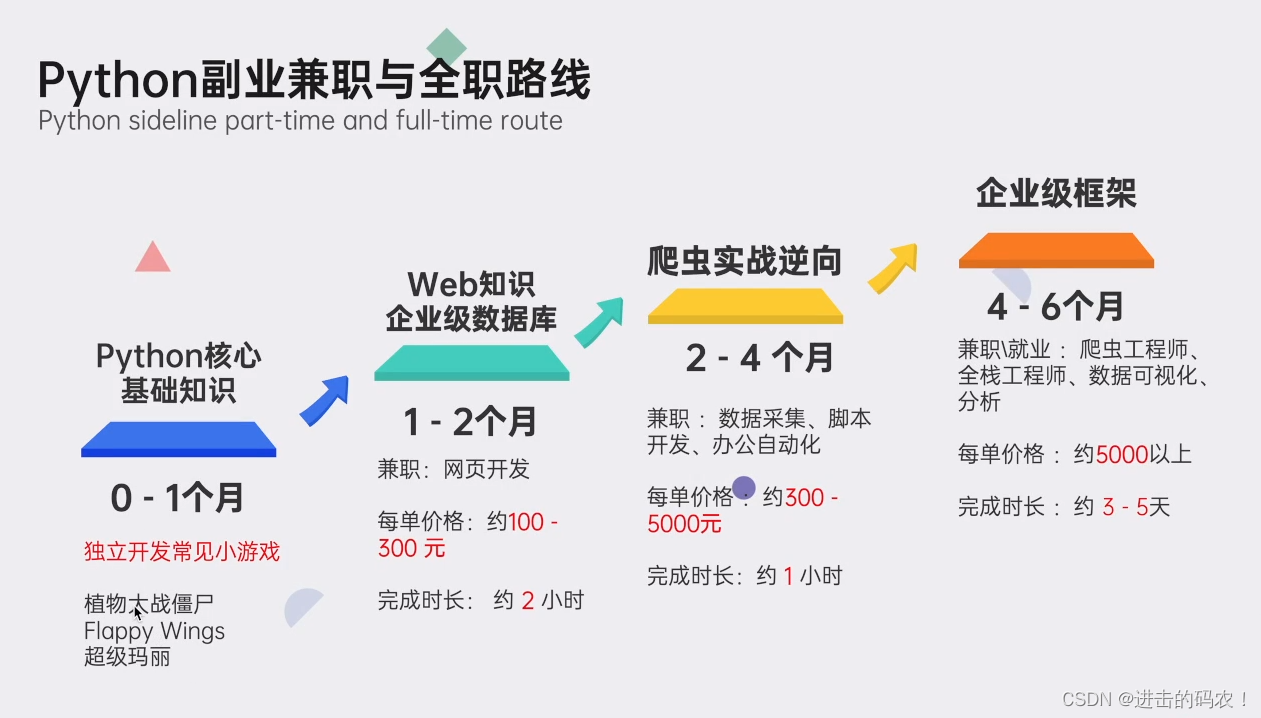Python由荷兰数学和计算机科学研究学会 于1990 年代初设计,作为一门叫做ABC语言的替代品。Python语法和动态类型,以及解释型语言的本质,使它成为多数平台上写脚本和快速开发应用的编程语言。
目录
为什么使用Python
Python应用场合
Hello world
国际化支持
便易用的计算器
字符串,ASCII和UNICODE
使用List
条件和循环语句
如何定义函数
文件I/O
异常处理
类和继承
包机制
为什么使用Python
假设我们有这么一项任务:简单测试局域网中的电脑是否连通.这些电脑的ip范围从192.168.0.101到192.168.0.200.
思路:用shell编程.(Linux通常是bash而Windows是批处理脚本).例如,在Windows上用ping ip 的命令依次测试各个机器并得到控制台输出.由于ping通的时候控制台文本通常是"Reply from … " 而不通的时候文本是"time out … " ,所以,在结果中进行字符串查找,即可知道该机器是否连通.
实现:Java代码如下:
String cmd="cmd.exe ping ";
String ipprefix=“192.168.10.”; int begin=101; int end=200;
Process p=null; for(int i=begin;i<end;i++){
p= Runtime.getRuntime().exec(cmd+i);
String line = null;
BufferedReader reader = new BufferedReader(new InputStreamReader(p.getInputStream()));
while((line = reader.readLine()) != null)
{
//Handling line , may logs it. }
reader.close();
p.destroy();
}
这段代码运行得很好,问题是为了运行这段代码,你还需要做一些额外的工作.这些额外的工作包括:
编写一个类文件
编写一个main方法
将之编译成字节代码
由于字节代码不能直接运行,你需要再写个小小的bat或者bash脚本来运行.
当然,用C/C++同样能完成这项工作.但C/C++不是跨平台语言.在这个足够简单的例子中也许看不出C/C++和Java实现的区别,但在一些更为复杂的场景,比如要将连通与否的信息记录到网络数据库.由于Linux和Windows的网络接口实现方式不同,你不得不写两个函数的版本.用Java就没有这样的顾虑.
同样的工作用Python实现如下:
import subprocess
cmd=“cmd.exe” begin=101 end=200 while begin<end:
p=subprocess.Popen(cmd,shell=True,stdout=subprocess.PIPE,
stdin=subprocess.PIPE,
stderr=subprocess.PIPE)
p.stdin.write(“ping 192.168.1.”+str(begin)+“\n”)
p.stdin.close()
p.wait()
print “execution result: %s”%p.stdout.read()
对比Java,Python的实现更为简洁,你编写的时间更快.你不需要写main函数,并且这个程序保存之后可以直接运行.另外,和Java一样,Python也是跨平台的.
有经验的C/Java程序员可能会争论说用C/Java写会比Python写得快.这个观点见仁见智.我的想法是当你同时掌握Java和Python之后,你会发现用Python写这类程序的速度会比Java快上许多.例如操作本地文件时你仅需要一行代码而不需要Java的许多流包装类.各种语言有其天然的适合的应用范围.用Python处理一些简短程序类似与操作系统的交互编程工作最省时省力.
Python应用场合
足够简单的任务,例如一些shell编程.如果你喜欢用Python设计大型商业网站或者设计复杂的游戏,悉听尊便.
Hello world
安装完Python之后(我本机的版本是2.5.4),打开IDLE(Python GUI) , 该程序是Python语言解释器,你写的语句能够立即运行.我们写下一句著名的程序语句:
print “Hello,world!”
并按回车.你就能看到这句被K&R引入到程序世界的名言.
在解释器中选择"File"–“New Window” 或快捷键 Ctrl+N , 打开一个新的编辑器.写下如下语句:
print “Hello,world!”
raw_input("Press enter key to close this window! ");
保存为a.py文件.按F5,你就可以看到程序的运行结果了.这是Python的第二种运行方式.
找到你保存的a.py文件,双击.也可以看到程序结果.Python的程序能够直接运行,对比Java,这是一个优势.
国际化支持
我们换一种方式来问候世界.新建一个编辑器并写如下代码:
print “欢迎来到奥运中国!”
raw_input(“Press enter key to close this window!”);
在你保存代码的时候,Python会提示你是否改变文件的字符集,结果如下:
-- coding: cp936 --
print “欢迎来到奥运中国!”
raw_input("Press enter key to close this window! ");
将该字符集改为我们更熟悉的形式:
-- coding: GBK --
print “欢迎来到奥运中国!” # 使用中文的例子
raw_input(“Press enter key to close this window”);
程序一样运行良好.
便易用的计算器
用微软附带的计算器来计数实在太麻烦了.打开Python解释器,直接进行计算:
a=100.0
b=201.1
c=2343
print (a+b+c)/c
字符串,ASCII和UNICODE
可以如下打印出预定义输出格式的字符串:
print “”" Usage: thingy [OPTIONS]
-h Display this usage message
-H hostname Hostname to connect to “”"
字符串是怎么访问的?请看这个例子:
word=“abcdefg” a=word[2]
print "a is: "+a
b=word[1:3]
print "b is: "+b # index 1 and 2 elements of word.
c=word[:2]
print "c is: "+c # index 0 and 1 elements of word.
d=word[0:]
print "d is: "+d # All elements of word.
e=word[:2]+word[2:]
print "e is: "+e # All elements of word.
f=word[-1]
print "f is: "+f # The last elements of word.
g=word[-4:-2]
print "g is: "+g # index 3 and 4 elements of word.
h=word[-2:]
print "h is: "+h # The last two elements.
i=word[:-2]
print "i is: "+i # Everything except the last two characters
l=len(word)
print "Length of word is: "+ str(l)
请注意ASCII和UNICODE字符串的区别:
print “Input your Chinese name:” s=raw_input("Press enter to be continued ");
print "Your name is : " +s;
l=len(s)
print “Length of your Chinese name in asc codes is:”+str(l);
a=unicode(s,“GBK”)
l=len(a)
print “I’m sorry we should use unicode char!Characters number of your Chinese \ name in unicode is:”+str(l);
使用List
类似Java里的List,这是一种方便易用的数据类型:
word=[‘a’,‘b’,‘c’,‘d’,‘e’,‘f’,‘g’]
a=word[2]
print "a is: "+a
b=word[1:3]
print "b is: " print b # index1 and 2 elements of word.
c=word[:2]
print "c is: " print c # index0 and 1 elements of word.
d=word[0:]
print "d is: " print d # All elements of word.
e=word[:2]+word[2:]
print "e is: " print e # All elements of word.
f=word[-1]
print "f is: " print f # The last elements of word.
g=word[-4:-2]
print "g is: " print g # index3 and 4 elements of word.
h=word[-2:]
print "h is: " print h # The last two elements.
i=word[:-2]
print "i is: " print i # Everything except the last two characters
l=len(word)
print "Length of word is: "+ str(l)
print "Adds new element[图片上传中…(image-b4ced-1616074265420-0)] " word.append(‘h’)
print word
条件和循环语句
Multi-way decision
x=int(raw_input(“Please enter an integer:”)) if x<0:
x=0 print"Negative changed to zero" elif x==0:
print “Zero” else:
print “More” # Loops List
a= [‘cat’, ‘window’, ‘defenestrate’] for x ina:
print x, len(x)
如何定义函数
Define and invoke function.
def sum(a,b):
return a+b
func = sum
r = func(5,6)
print r
Defines function with default argument
def add(a,b=2):
return a+b
r=add(1)
print r
r=add(1,5)
print r
并且,介绍一个方便好用的函数:
The range() function
a =range(5,10)
print a
a = range(-2,-7)
print a
a = range(-7,-2)
print a
a = range(-2,-11,-3) # The 3rd parameter stands for step
print a
文件I/O
spath=“D:/download/baa.txt” f=open(spath,“w”) # Opens file for writing.Creates this file doesn’t exist. f.write(“First line 1.\n”)
f.writelines(“First line 2.”)
f.close()
f=open(spath,“r”) # Opens file forreading for line in f:
print line
f.close()
异常处理
s=raw_input(“Input your age:”) if s ==“”:
raise Exception(“Input must no be empty.”) try:
i=int(s)
except ValueError:
print “Could not convert data to an integer.” except:
print"Unknown exception!" else: # It is useful for code that must be executed if the try clause does not raise an exception
print “You are %d” % i," years old" finally: # Clean up action
print “Goodbye!”
类和继承
class Base:
def init(self):
self.data =[]
def add(self, x):
self.data.append(x)
def addtwice(self, x):
self.add(x)
self.add(x)
Child extends Base class Child(Base):
def plus(self,a,b):
return a+b
oChild =Child()
oChild.add(“str1”)
print oChild.data
print oChild.plus(2,3)
包机制
每一个.py文件称为一个module,module之间可以互相导入.请参看以下例子:
a.py
def add_func(a,b):
return a+b
b.py
from a import add_func # Also can be : import a
print “Import add_func from module a”
print"Result of 1 plus 2 is: " print add_func(1,2) # If using “import a” , then here should be “a.add_func”
module可以定义在包里面.Python定义包的方式稍微有点古怪,假设我们有一个parent文件夹,该文件夹有一个child子文件夹.child中有一个module a.py . 如何让Python知道这个文件层次结构?很简单,每个目录都放一个名为_init_.py 的文件.该文件内容可以为空.这个层次结构如下所示:
parent
–_init.py
–child
– _init.py
–a.py
b.py
那么Python如何找到我们定义的module?在标准包sys中,path属性记录了Python的包路径.你可以将之打印出来:
import sys
print sys.path
通常我们可以将module的包路径放到环境变量PYTHONPATH中,该环境变量会自动添加到sys.path属性.另一种方便的方法是编程中直接指定我们的module路径到sys.path 中:
import sys
sys.path.append(‘D:\download’)
from parent.child.a import add_func
print sys.path
print “Import add_func from module a” print"Result of 1 plus 2 is: " print add_func(1,2)
关于Python技术储备
学好 Python 不论是就业还是做副业赚钱都不错,但要学会 Python 还是要有一个学习规划。最后大家分享一份全套的 Python 学习资料,给那些想学习 Python 的小伙伴们一点帮助!
包括:Python激活码+安装包、Python web开发,Python爬虫,Python数据分析,Python自动化测试学习等教程。带你从零基础系统性的学好Python!
👉[[CSDN大礼包:《python安装包&全套学习资料》免费分享]](安全链接,放心点击)

一、Python大礼包
Python所有方向的技术点做的整理,形成各个领域的知识点汇总,它的用处就在于,你可以按照上面的知识点去找对应的学习资源,保证自己学得较为全面。

二、 Python电子书

三、入门学习视频

四、 Python爬虫秘笈
光学理论是没用的,要学会跟着一起敲,要动手实操,才能将自己的所学运用到实际当中去,这时候可以搞点实战案例来学习。

五、 数据分析全套资源

六、python副业兼职与全职路线

上述这份完整版的Python全套学习资料已经上传CSDN官方,如果需要可以微信扫描下方CSDN官方认证二维码 即可领取






















 2万+
2万+











 被折叠的 条评论
为什么被折叠?
被折叠的 条评论
为什么被折叠?








